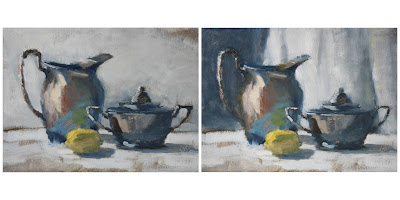 |
| "Lady with an Ermine" Leonardo daVinci, c. 1489 |
My last post was about the process of starting a painting, so it's only fitting to write now about the process of finishing. The start of a painting happens very quickly, with each brushstroke following rapidly on the heels of the prior one. But the ending happens very slowly. Toward the end, before every stroke, I pause and consider "Will this help or hurt?" And then there is the ultimate question--is it time to stop? The answer is seldom obvious.
 |
| "Patina" 12 x 16, Oil on Linen (c) Lesley Powell 2016 SOLD |
For some artists, a painting is never finished. At least not until it leaves the studio--and sometimes not even then (see below). As time passes, you have the opportunity to reflect on the painting. You may return to it after a few weeks with fresh eyes. Sometimes that fresh vision causes you to notice something that just begs to be adjusted. Then out come the
brushes again! Just above you can see a painting that I THOUGHT was finished, until I came back to it a few days later, and decided it looked too stark. I pulled out some fabric, and set to work to create a curtained background. You be the judge whether it helped or hurt!
One of the most famous re-do's is that of John Singer Sargent's "Madame X". The portrait originally had the shoulder strap on Madame's gown slipping off her shoulder down her arm (top image). The painting caused quite a scandal--it was considered far too provocative. Sargent ultimately re-painted the shoulder strap to place it securely on Madame's shoulder.
Detail from "Madame X"
John Singer Sargent
Sargent was not the only great Master to experience changes of heart. The top image shows two under-layers of Leonardo da Vinci's famous "Lady with an Ermine". The final painting, as we know it today, is on the far right. You can see that da Vinci changed the painting several times. First, he painted the portrait without the ermine. Then with. Then with a different ermine.
In another example, the great French painter Pierre Bonnard used to revise his paintings time and time again, often many years after their "completion". Just above, on the left, you see "The Work Table", which Bonnard painted in 1927. He returned to it again ten years later, and simplified the rug, as you see on the right. I wonder whether that rug had been nagging him for ten years.
 |
| "Work Table" Oil on Canvas, 48 x 36 inches Pierre Bonnard, 1926 / 1937 |
I have read that on visits to the Luxembourg Museum in Paris, Bonnard would enlist the help of his friend and fellow artist Edouard Vuillard so that he (Bonnard) could make surreptitious touch-ups to his paintings. Vuillard would distract the museum guards, and while they were distracted, Bonnard would pull out his paint box and add a few touches to his paintings. I guess it's true that artists are never really satisfied with their own work--one always believes there is room for improvement!



No comments:
Post a Comment